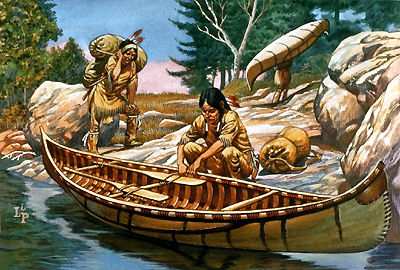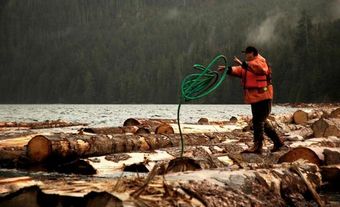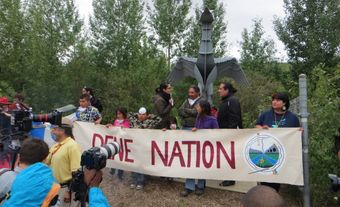Population and Territory
(courtesy Native Land Digital / Native-Land.ca)
The Algonquin are Indigenous peoples in Canada, whose home communities are located in western Quebec and adjacent Ontario, centring on the Ottawa River and its tributaries.
Algonquin should not be confused with Algonquian, or Algonkian, which is used to describe a much larger linguistic and cultural group, which includes the Anishinaabeg, as well as the Innu and Cree.
Algonquin people are closely related to Ojibwe and Odawa, with whom they form the larger cultural group known as the Anishinaabeg — also known as Anishinaabek, or Anishinaabe in the singular.
In the 2021 census, 30,390 people identified as having Algonquin ancestry.
Pre-contact Life
Algonquin nations hunted, traded and lived in large territories in the Eastern Woodlands and Subarctic regions, and were largely independent of one another. Like their Anishinaabeg relatives, the Algonquin lived in easily disassembled birch bark dwellings known as wigwams, and shared knowledge of their culture through oral history. In the southernmost locations where both climate and soils permitted, some groups practiced agriculture.
Society and Culture
The Algonquin lived in communities comprised of related patrilineal clans (meaning they followed the male line of descent). Clans were represented by animal totems such as Crane, Wolf, Bear, Loon and many others. The communities were egalitarian, with leadership provided by respected Elders and heads of clans. Intermarriage within a clan was forbidden, even if the parties were from separate communities.
Relations between an Algonquin band and other Indigenous groups depended largely on local conditions. Generally, relations between neighbouring communities were tempered by kinship ties regardless of language or other designations. However, relations with the Haudenosaunee (Iroquois) nations were turbulent, with hostilities most pronounced during the 17th and 18th centuries; however, some Algonquin lived peacefully alongside Catholic Haudenosaunee at Oka, a mission reserve near Montreal.
Language
The Algonquin language, also known as Omàmiwininìmowin, is part of the Algonquian language family. The word Omàmiwininì, the root of Omàmiwininìmowin, is often used by the community at large to describe Algonquin people in particular.
The Algonquian linguistic group includes a number of languages, including those of the Atikamekw, Blackfoot, Cree, Wolastoqiyik, Mi’kmaq, Innu, Naskapi, Ojibwe and Oji-Cree. According to the 2021 census, the Algonquian language group was the largest in Canada. Approximately 160,980 people claimed knowledge of a language within this group.
However, the Algonquin language is considered endangered, with 1,925 people identified as having knowledge of the language in the 2021 census. Algonquin communities actively work to promote and preserve their language through various programs, such as community-led education initiatives and university-level language courses. (See also Indigenous Languages in Canada.)
DID YOU KNOW?
The Algonquin language is intrinsically linked to place names in Canada, as many early French explorers mapped or named topographic features using Algonquin words. For example, Quebec comes from the Algonquin word kébec, meaning “place where the river narrows.”
Religion and Spirituality
Though many Algonquin people were converted to Christianity by missionaries, many Algonquin religious beliefs and customs persist. The underlying spirit or life force in many Algonquin oral histories is Manitou, a supernatural being that manifested in a number of different characters, including the Windigo, Wisakedjak and Nanabozo. ( See also Religion and Spirituality of Indigenous Peoples in Canada.)
Colonial History
The Algonquin have been known to Europeans since 1603, when Samuel de Champlain encountered them with a number of allies at Tadoussac. They became allies of the French along with the Innu (Montagnais-Naskapi) and Huron-Wendat against the Haudenosaunee. In order to facilitate the fur trade, Algonquin groups made military and trade alliances with both Indigenous and French allies. Throughout this period, war with the Haudenosaunee and disease brought by European traders and missionaries decimated Algonquin communities, weakening their political and territorial influence. (See also Epidemic.)
After the Peace of Montreal in 1701, which ended hostilities with the Haudenosaunee, many Algonquin people frequently travelled to Montreal and participated actively in the fur trade. Once the British defeated the French in North America and issued the Royal Proclamation in 1763, Algonquin people had claim to large portions of the Ottawa River watershed, though increasingly European settlement threatened those rights.
During the 19th century, Algonquin communities began to petition the government for lands to be set aside for reserves. These communities were often established near former trading posts, where land outside the reserve was being sold or granted to European settlers. This continued into the 20th century, as further settlement and the establishment of residential schools threatened and undermined traditional Algonquin ways of life.
The lingering effects of residential schools, cultural and generational dislocation, coupled with the seizure of traditional lands have left many Algonquin communities in poor condition. (See also Social Conditions of Indigenous Peoples in Canada.) However, many communities, like the Algonquins of Pikwakanagan in Ontario, have taken action to address systemic social issues with the establishment of community health programs, daycare, supportive housing and other programs.
Contemporary Life
Many Algonquin communities remain active in fighting for Indigenous rights with ongoing treaty negotiation between the Algonquin people in Ontario and the Governments of Ontario and Canada. The negotiations represent an acknowledgement that Algonquin people never signed a treaty with the Crown, and therefore are entitled to lay claim to land never surrendered.
In October 2016, the Algonquins of Ontario signed a land claim agreement-in-principle (i.e., a step towards a final contract) with the Canadian and Ontario governments that covers 36,000 km2 of land in eastern Ontario. As part of the deal, 117,500 acres (475.505 km2) of Crown land will be transferred to the Algonquins of Ontario. In addition, the Algonquin will be awarded $300 million total from both levels of government, as well as rights to the land and natural resources. Algonquin peoples in Quebec and other Indigenous nations, such as the Haudenosaunee, have criticized the agreement-in-principle, arguing that the land claim overlaps their territory. There is also a dispute over who qualifies as Algonquin under the agreement. While the final details of what will be Ontario’s first modern treaty may take years to ratify, it remains an historic agreement — one that has taken 24 years to negotiate.

 Share on Facebook
Share on Facebook Share on X
Share on X Share by Email
Share by Email Share on Google Classroom
Share on Google Classroom






